
Hospice gardens do not immediately spring to mind as ‘must go to visit attraction’. However while on child care duties in south London last weekend I took the opportunity to visit The Royal Trinity Hospice, Clapham Common which kindly opened its gates to the public in aid of the National Garden Scheme.

The Hospice, with its elegant facade situated on the north side of Clapham Common is the oldest hospice in the UK and was created in 1891 with thanks to the generosity of William Hoare who donated £1,000 of the £2,000 needed to set up what was known as The Hostel of God, the remainder of the funds being raised by public subscription. Originally situated around the corner in The Chase, the hospice by 1894 had 10 beds and patients were cared for by an order of nuns. In 1899 the hospice moved here to Clapham Common Northside, where it has expanded and evolved over the years with the late 1970s – 1980s seeing a significant rebuilding programme in order to improve the facilities and patient care environment.
It was during this time that the renowned landscape architect Lanning Roper visited the site and, waiving his fee, drew up plans for the 2 acre garden.

Roper did not live to see his plans carried out, dying in 1983. So landscape architect John Medhurst was commissioned to lay out the garden, and included in his design such details as Roper’s generous curving brick paths which not only gently lead you to a hidden area but help those in a wheelchair glide seamlessly through the garden so as to enjoy the planting.

The majority of hospices rely on an army of volunteers, several of whom last Sunday gave up their time to greet us at the gate, directing us in through a side door. An easy access, with neither gravel nor steps, a joy for wheelchair or buggy users and something many garden owners where possible, might seriously think about.
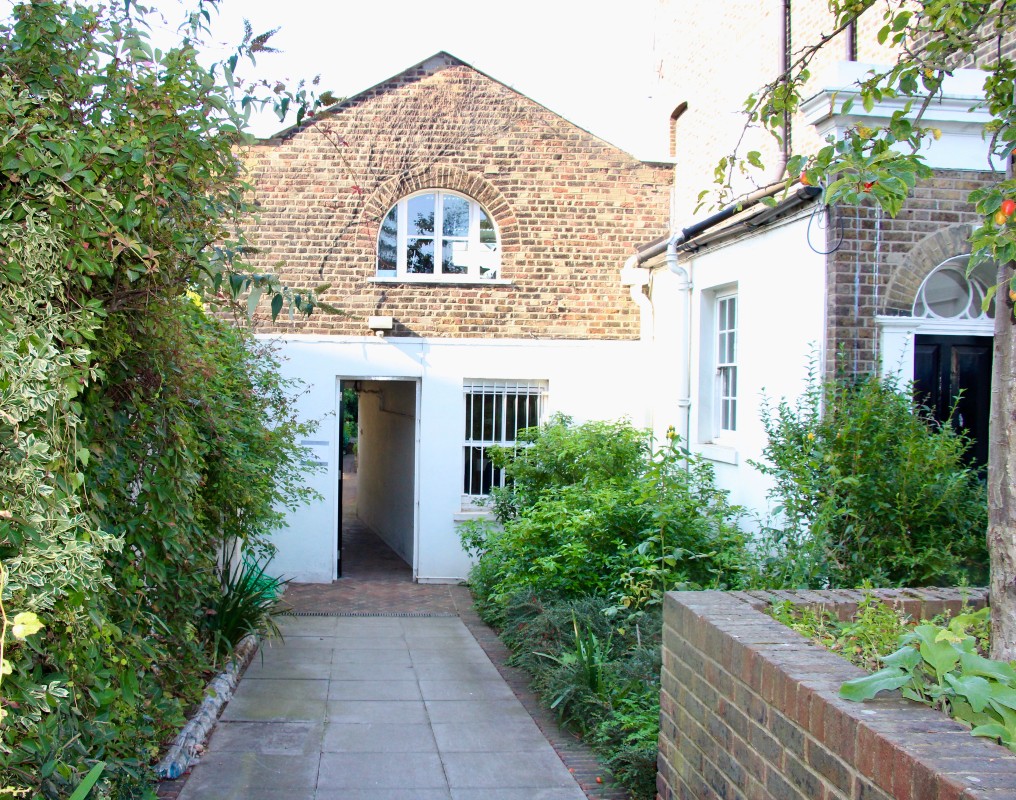
You might be forgiven for expecting an uninteresting hospitalised space, a touch morbid even; instead however, you would in that first moment immediately feel that this is indeed a very special green space.

The raised beds on either side are well planted and display a rich variety: aromatic herbs mingle together along the left hand side,

on the other, a rose defies the approach of autumn and flowers steadily as if it is June

whilst the rugosas are into their autumn hips.

There is even a touch of wilding to be enjoyed.

Paths bend and flow, and as in life, choices need to be made….

it is the benign sound of water trickling down into the ornamental pond that beckons us round to the right.

Climbing up the steps it is the generous colourful pots which bring a splash of joy to those hard landscaping areas,
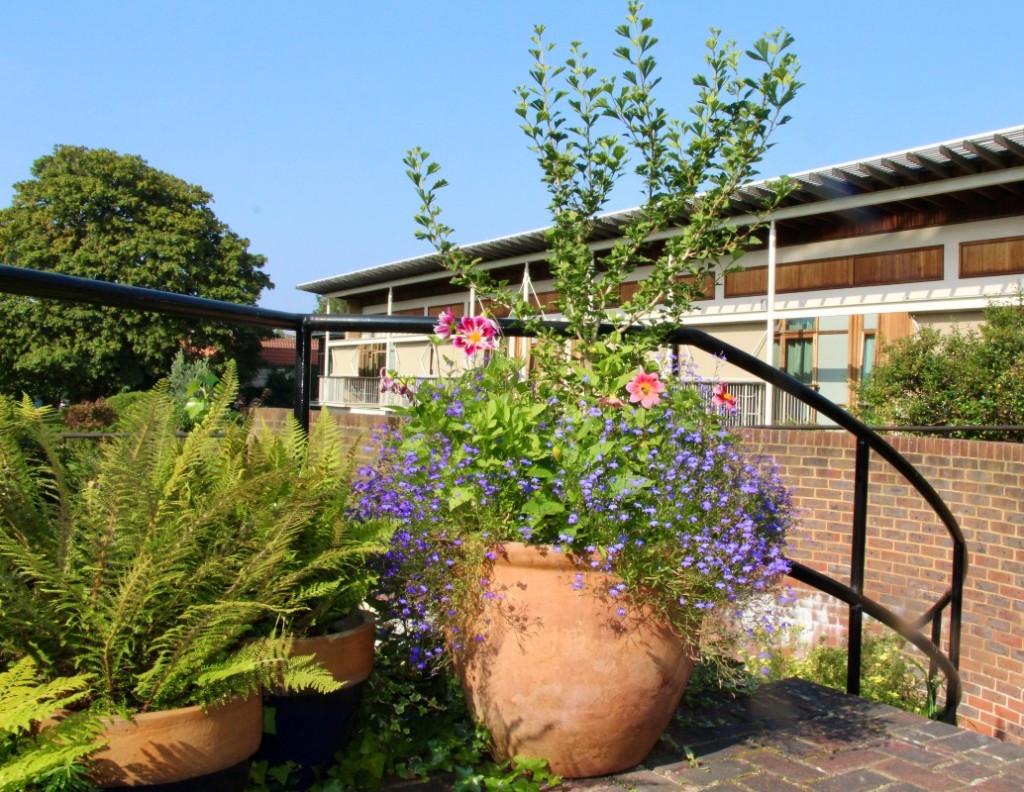
and from the balcony above the circular pond there is an opportunity to look out and take in the serenity and size of this mature two-acre London garden.
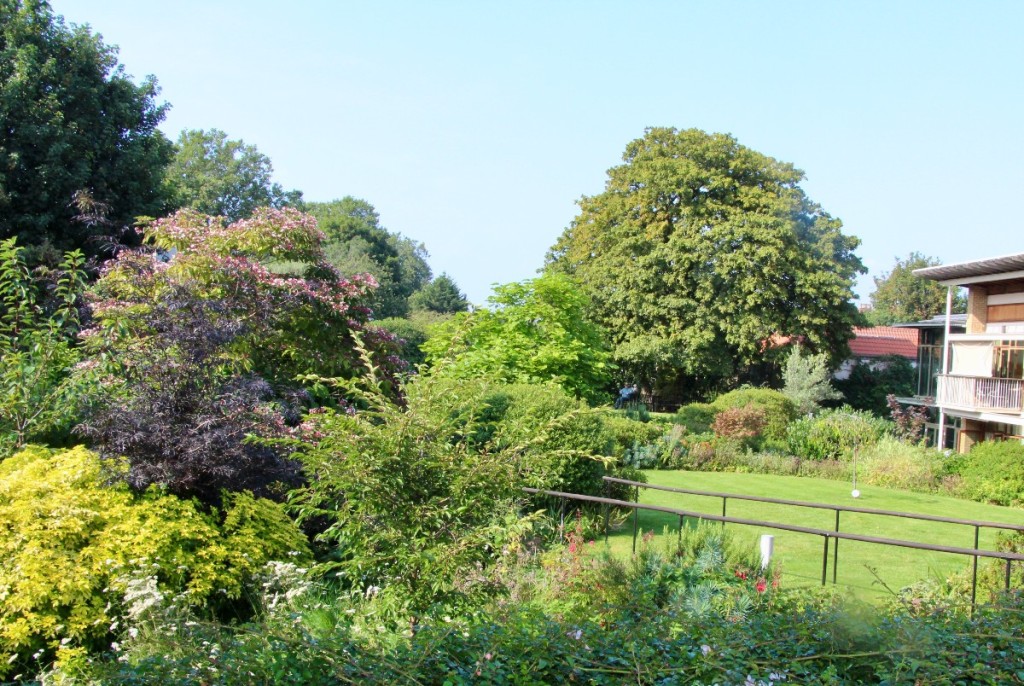
Descending the steps we begin to explore the many hidden areas. A substantial clerodendron grows beside an intimate area. This shrub is very happy here sending up suckers across the path; a native to China it is a quirky coincidence that the roof behind has a slightly oriental feel.

A grassy enclave is home to a fine Catalpa tree , its trunk needing support, it happily grows on.

The gardens were very dilapidated before Roper was involved and his first priority were the trees. This old Horse Chestnut tree provides not only a point of interest but also a marker between two separate areas. Its branches must hold many a secret of those conversations shared beneath on the deep seated benches.

Beyond the tree there is quite a different feel as we enter the pond area. Hospices are not just about the patients who are dying but also for those who remain to live on. Here is a perfect place to absorb all the many emotions that go with that unknown future. This afternoon it is pure joy for the first time in weeks, to benefit from the sunshine and the dappled shade.
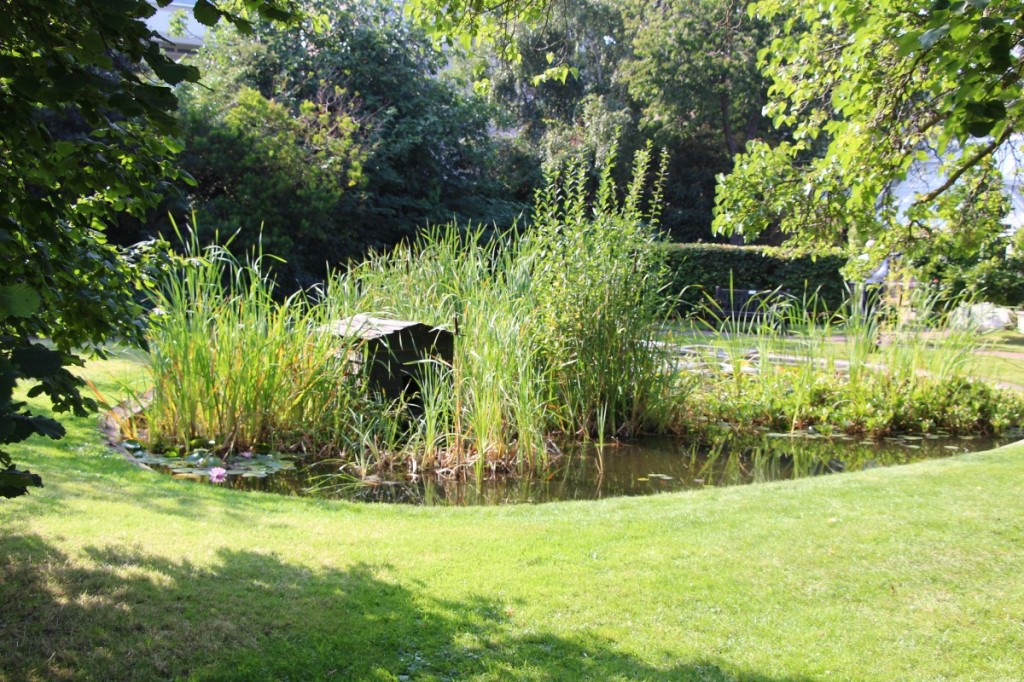
Situated on one side of the pond is the kinetic sculpture entitled ‘Four Open Squares Horizontal Tapered’ (1984) by George Rickey, its subtle movement by the breeze from time to time provides an absorbing distraction,

whilst a monster lurks in the deep below.

There is a high standard of horticulture here and the Head Gardener has 28 volunteers to keep in order; it looks a serious business.

Behind the pond stands a substantial greenhouse,

next to which is the productive area providing an air of home-grown; the runner beans are prolific,
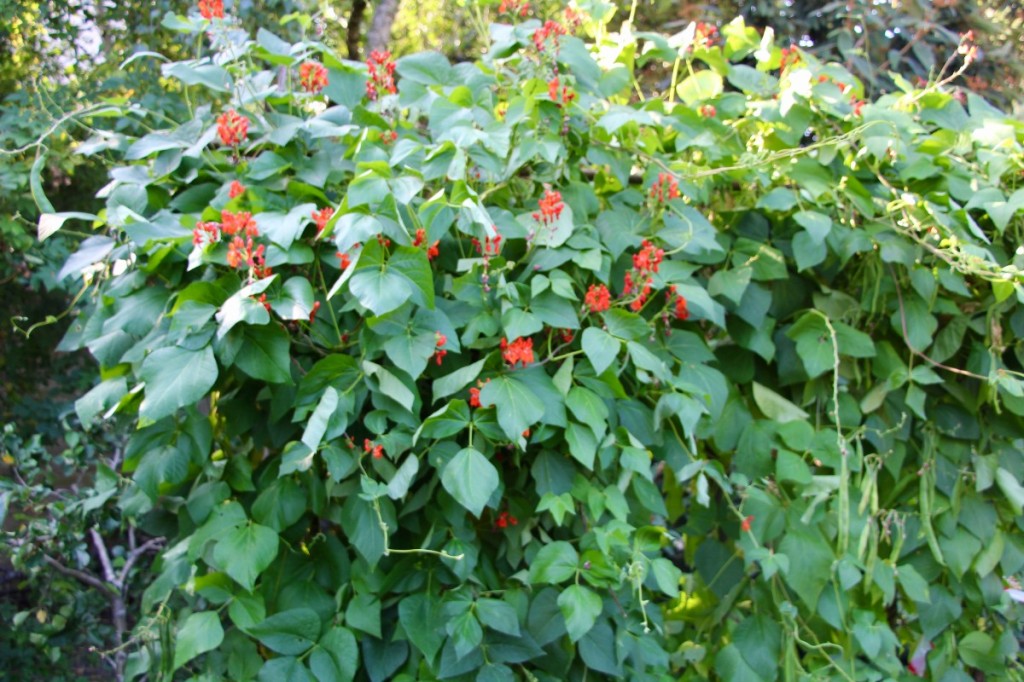
and strawberries too, in their own patch.

There is even an active and busy bee hive which produces Trinity House Honey.

Roper suggested the paths be kept clean with neatly trimmed hedges enticing you to journey into the next space.

He also suggested a palette of soft blue, silver, pink and white which continues to this day. Patients can enjoy the mix from their rooms.

The site is divided in two parts with the modern inpatient complex at the centre. We walk up the steps to where mature trees dominate a fine circular lawn. The Plane tree provides a good meeting place,

with elegant circular seating around its base.
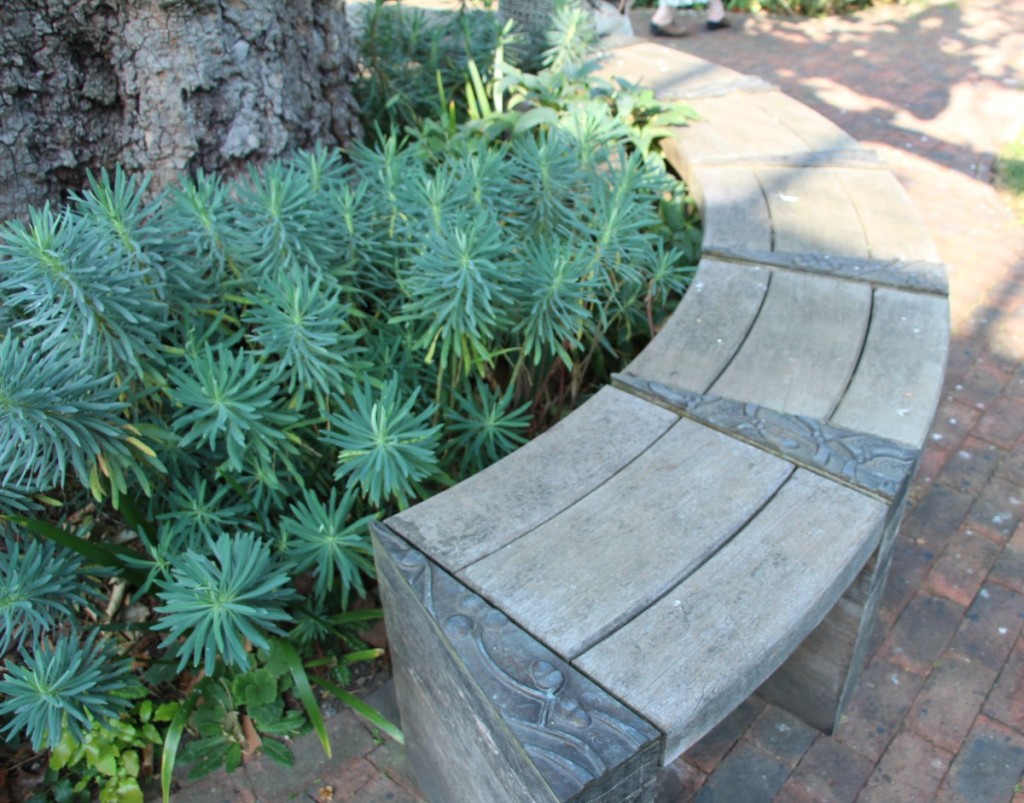
The circular theme is echoed in the perimeter path from where
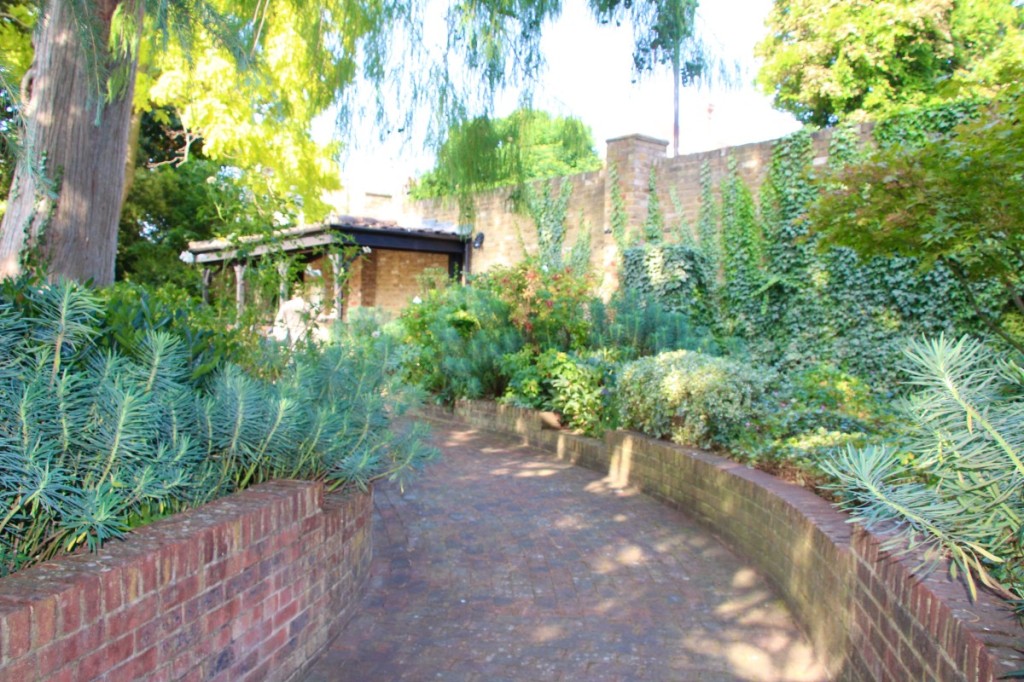
you can glimpse through the shrubs and trees the sun shining down onto the mown lawn where stands the round pleasing pebble sculpture.

Completed after his death the garden became a memorial for Lanning Roper and has been open every year since for the National Garden Scheme.

The Scheme is the largest funder of Hospice UK and has donated more than £5 million since 1996. To understand a little more of the work of Hospice UK click on this link and have a listen to the video too: https://www.hospiceuk.org/support-us/work-with-us/corporate-partnerships/our-corporate-partners/the-national-garden-scheme
Our local hospice in West Norfolk has only recently been built and with it, a beautiful garden planted by volunteers. Let us hope they will sometime soon find a way to open their gates so that visitors can not only appreciate the valuable contribution that hospices make but also help raise funds for the National Garden Scheme.
——-2021——-
A really wonderful and thought-provoking read.
LikeLike
I think the greatest contribution to the continuing beauty of this garden has come from those who maintain it. So often I have seen such gardens put in the hands of a “handyman” who trims every shrub in the place into a sphere or worse, into a cube! The planting has kept a beautifully natural look to it and it is a great credit to those who work there and a joy, I imagine to visitors as well.
I walked around this way many a time!
LikeLiked by 2 people
What a lovely, thoughtfully written, piece Julia. I enjoyed taking a virtual walk around a garden which I am not likely to ever visit.
LikeLike
This garden touches my heart even though I can’t see it in person. My sister is now in hospice. This post couldn’t have come at a better time. Thank you.
LikeLike
I so enjoyed reading this and what better therapy for very sick people and their visitors than being able to meander in such a garden. I hope all those who are there now will take a look through their own garden gate cos they will have an unexpected surprise. Lovely pictures and such vivid descriptions. I could almost smell the cloradendron! Susie
LikeLike
Gardens and music are such wonderful therapies that they should be integrated into hospitals as well as hospices.
LikeLike
Another lovely visit Julia, always described with panache! Thank you.
Still hoping we will see you in Yorkshire.
Margie
LikeLike
So informative and as always such fabulous photos.
LikeLike
What a lovely trip round this garden- a new one to me.It looked lovely and serene and your photos captured its feel and spirit,I think.
LikeLike
I am pretty sure Trinity was the first hospice garden to open for the National Garden Scheme and it continues to be one of the best and most interesting. A lovely circle for visitors to make direct contact with the hospice movement which is one of our major beneficiaries.
LikeLike
What a lovely sunny description, and I had no idea how huge the garden is nor how beautifully it is planted and looked after. Thank you for taking us through its garden gate.
LikeLike
Hi Julia, thanks for sharing this visit – beautifully described. As always, your interesting selection of images helps us to imagine we are walking around with you. It is clearly a special garden and a real credit to the HG, staff and volunteers at The Royal Trinity. Many thanks to them, and to you, for showing what an inspirational ‘win-win’ it can be when a hospice garden opens in partnership with the National Garden Scheme.
LikeLike